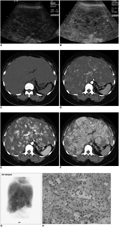Korean J Radiol.
2008 Dec;9(6):559-562. 10.3348/kjr.2008.9.6.559.
Diffuse Hepatic Hemangiomatosis without Extrahepatic Involvement in an Adult Patient
- Affiliations
-
- 1Department of Radiology, St. Vincent's Hospital, College of Medicine, The Catholic University of Korea, Gyeonggi-do, Korea. sshwang7@catholic.ac.kr
- KMID: 1118879
- DOI: http://doi.org/10.3348/kjr.2008.9.6.559
Abstract
- We report an extremely rare case of a diffuse hepatic hemangiomatosis without extrahepatic involvement in an adult. The imaging findings of this tumor were similar to those of a hepatic hemangioma and included contrast enhancement with a centripetal filling pattern of the entire hepatic tumor on the delayed phase of a dynamic CT and inhomogeneous diffuse uptake of the entire tumor on blood-pool images obtained five hours later on a 99mTc-labeled red blood cell scan. Despite its rarity, diffuse hepatic hemangiomatosis can be suggested in adult patients with diffusely involved hepatic tumors showing the radiological findings of a hepatic hemangioma.
Keyword
MeSH Terms
Figure
Reference
-
1. Lopriore E, Markhorst DG. Diffuse neonatal haemangiomatosis: new views on diagnostic criteria and prognosis. Acta Paediatr. 1999. 88:93–97.2. Lehmann FS, Beglinger C, Schnabel K, Terracciano L. Progressive development of diffuse liver hemangiomatosis. J Hepatol. 1999. 30:951–954.3. Moon WS, Yu HC, Lee JM, Kang MJ. Diffuse hepatic hemangiomatosis in an adult. J Korean Med Sci. 2000. 15:471–474.4. Langner C, Thonhofer R, Hegenbarth K, Trauner M. Diffuse hemangiomatosis of the liver and spleen in an adult. Pathologe. 2001. 22:424–428.5. Latifi HR, Siegel MJ. Diffuse neonatal hemangiomatosis: CT findings in an adult. J Comput Assist Tomogr. 1992. 16:971–973.6. Ohnishi S, Miyagishima T, Nakagawa M, Kamata T, Kishimoto A, Choi GH, et al. Diffuse neonatal hemangiomatosis without cutaneous lesions in an adult-a case report. Angiology. 2002. 53:235–237.7. Bishop PR, Nowicki MJ, Parker PH. Radiological case of the month. Hepatic hemangiomatosis. Arch Pediatr Adolesc Med. 2000. 154:743–774.8. Feurle GE. Arteriovenous shunting and cholestasis in hepatic hemangiomatosis associated with metoclopramide. Gastroenterology. 1990. 99:258–262.9. Buetow PC, Buck JL, Ros PR, Goodman ZD. Malignant vascular tumors of the liver: radiologic-pathologic correlation. Radiographics. 1994. 14:153–166.10. Conter RL, Longmire WP Jr. Recurrent hepatic hemangiomas. Possible association with estrogen therapy. Ann Surg. 1988. 207:115–119.11. Frangides C, Kounis NG, Papadaki PJ, Goudevenos J, Zabras GM. Diffuse hepatic hemangiomatosis in the elderly. Br J Clin Pract. 1995. 49:215–216.
- Full Text Links
- Actions
-
Cited
- CITED
-
- Close
- Share
- Similar articles
-
- Diffuse hepatic hemangiomatosis in an adult
- Diffuse Neonatal Hemangiomatosis
- Eruptive Neonatal Hemangiomatosis
- Giant cavernous hemangioma coexistent with diffuse hepatic hemangiomatosis presenting as portal vein thrombosis and hepatic lobar atrophy
- Diffuse Neonatal Hemangiomatosis Successfully Treated with High Dose Corticosteroid


